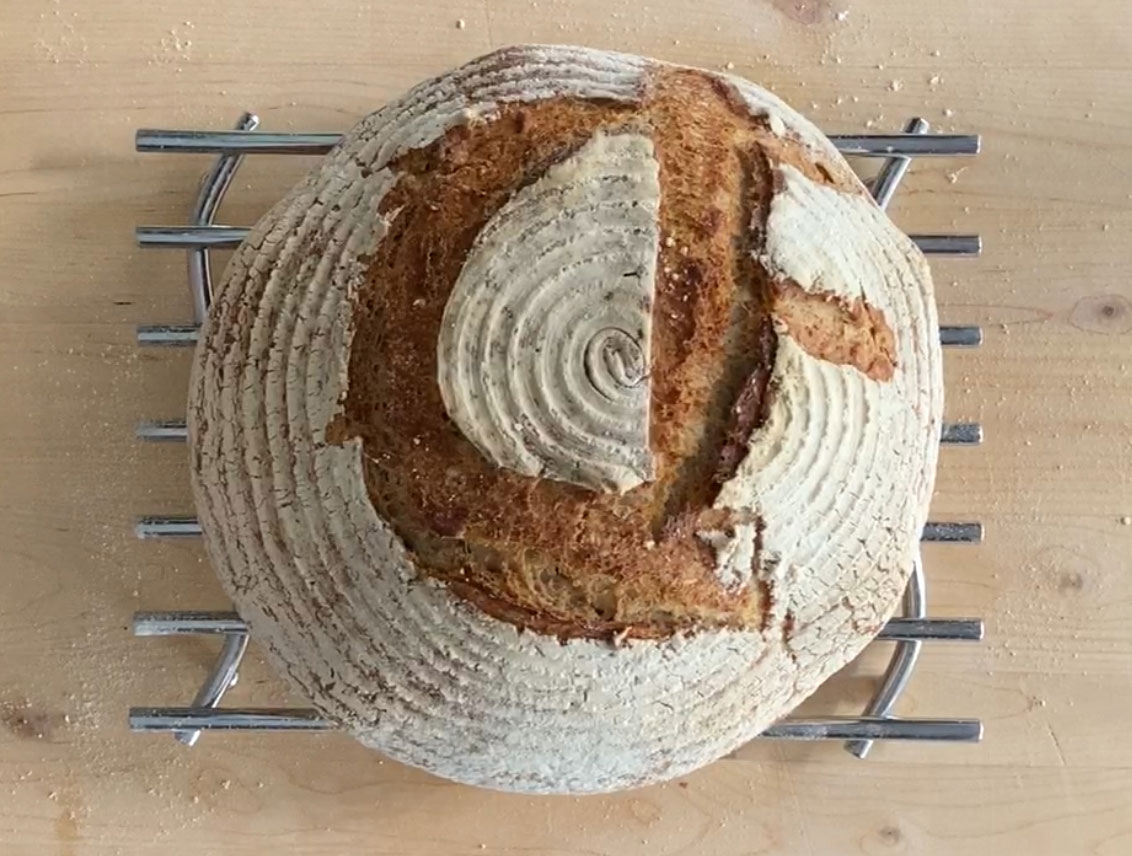The original recipe for pain Poilâne, the famous Parisian artisan bakery bread, is not available to mere mortals. Mine is as close as possible except for the addition of 'old dough' or baking in a wood fired oven.

What is Poilâne?
Poilâne is the legendary, best-in-the-world loaf of bread or 'miche' as per the French word for 'loaf'. This epitome of artisanal traditional loaf, made all by hand, was developed by Pierre and then his son Lionel Poilâne in a Parisian boulangerie in 1930s.
The bakery is at present run by Apollonia Poilâne, Lionel’s eldest daughter.
What's special about Poilâne bread?
Pain Poilâne is all about stoneground flour, natural fermentation and wood-fired oven. Lacking the last element, I can’t very well say I make authentic pain Poilâne!
And anyway I believe the recipe is a bit of a secret squirrel, in the league with Sacher, Coca-Cola and KFC crispy breadcrumbs (okay – I KNOW the other two are not in the same league as Sacher).
But the loaf that comes out of this recipe is outstanding.
What flour goes into Poilâne?
What is known is that the bread uses stoneground whole wheat flour, but with some of the bran removed, just to be extra pernickety in a Parisian way. There is an addition of spelt flour too, and my version has a little rye as well, after Breadtopia’s excellent instructions.
The salt used in baking should be grey Normandy, sel gris de Guerande.
If you want to be super-true to form, sieve off the bran from half the amount of your stoneground wholemeal flour. So far every time I've made it, I considered life too short for sifting half a pound of flour - or more, since your final amount is measured after sifting.
I should sincerely like to try and go the whole furlong one day though and do my sieving conscientiously. I promise to report on the outcome.
For the time being I replace the sifted wholemeal with strong white flour, stoneground whenever I can get it.
How is Poilâne made?
By hand – mostly. I cheat a little with my standing mixer: the dough is very firm to start off with so I set the ball (of dough) rolling in the mixer with a dough hook.
But after the dough becomes more pliant, elbow grease and proper artisan kneading is unavoidable, for at least 10 minutes.
It proves over 24 hours in the fridge – it’s a pretty leisurely loaf. The following day the dough is shaped, set for the final rise in some warmth and it’s baked, on a stone with a splash of water, or in a Dutch oven.
What else is special about miche Poilâne?
What is also known is that each next loaf is leavened with a little ‘old dough’ which I usually forget to put aside.
If you do reserve a chunk for future loaves, peek into the Basic Old Dough recipe to find out how to transfer the old dough aka pâte fermentée into starter dough.
Score your miche!
The original pain Poilâne has an elegant, shapely 'P' calligraphed on the loaf with a masterly stroke.
Easy to guess I try to score a 'CF' for Cuisine Fiend into mine. I know that looking at the images it is rather difficult to guess that it actually is supposed to be a 'CF'.
But who cares when the bread is that tasty?
More iconic sourdough recipes
San Francisco sourdough was reportedly developed by the California settlers of the Gold Rush era. The bread is as good as the gold.
The West Coast of US is famous for cult bakeries, and none better than Tartine Bakery, founded by Chad Robertson in San Francisco. Tartine country bread is definitely one of the best there is.
Off to the other end of the globe, to find Borodinsky, Russian dark rye sourdough, allegedly baked to give courage to the Russian troops before the battle of Borodino.
More French bread recipes
Croissants are probably the best-known French bread, and you can make these, pretty authentic ones.
French almost-crustless sandwich loaf, pain de mie, is baked in a special Pullman tin with a lid.
And last but not least, the best recipe for baguettes, fermenting over 46 hours and leavened on sourdough starter.